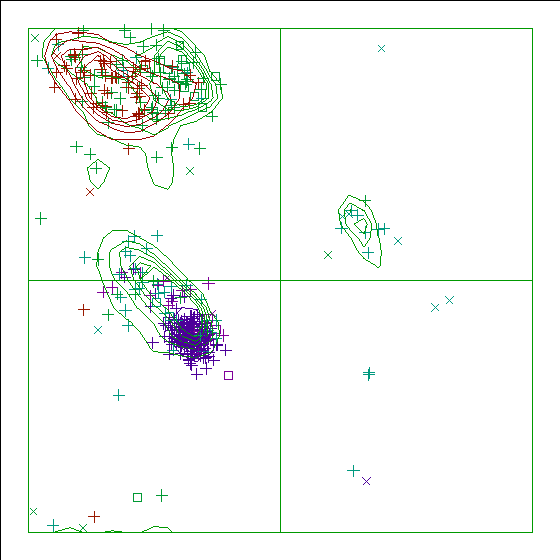
Improper dihedral RMS Z-score : 0.539
Note: Chain names are OK
All chain names assigned to polymer molecules are unique, and all
residue numbers are strictly increasing within each chain.
Note: Weights checked OK
All atomic occupancy factors ('weights') fall in the 0.0--1.0 range.
Geometric checks
Note: No missing atoms detected
All expected atoms are present.
Warning: C-terminal oxygen atoms missing
The C-atoms listed in the table below belong to a C-terminal residue
in a protein chain, but the C-terminal oxygen ("O2" or "OXT") that it
should be bound to was not found.
420 MET ( 429 ) C
Atom names starting with "<" belong to the previous residue in the chain. If the second atom name is "--SS", the disulphide bridge has a deviating length.
11 PHE ( 11 ) CA CB 1.623 4.6 311 GLU ( 320 ) N CA 1.548 4.7
RMS Z-score for bond lengths: 0.773
RMS-deviation in bond distances: 0.017
Note: No bond length directionality
Comparison of bond distances with Engh and Huber [REF] standard
values for protein residues and Parkinson et al [REF] values for
DNA/RNA does not show significant systematic deviations.
Note: All bond angles OK
All bond angles are in agreement with standard bond angles using a
tolerance of 4 sigma (both standard values and sigma for protein
residues have been taken from Engh and Huber [REF], for DNA/RNA
from Parkinson et al. [REF]). Please note that only bond angles
within protein residues are taken into account: disulphide bridges
and peptide bonds are neglected.
Note: Normal bond angle variability
Bond angles were found to deviate normally from the mean standard
bond angles (normal values for protein residues were taken from
Engh and Huber [REF], for DNA/RNA from Parkinson et al [REF]). The
RMS Z-score given below is expected to be around 1.0 for a normally
restrained data set, and this is indeed observed for very high
resolution X-ray structures. More common values are around 1.55
RMS Z-score for bond angles: 0.894
RMS-deviation in bond angles: 1.775
Note: Side chain planarity OK
All of the side chains of residues that have a planar group are
planar within expected RMS deviations.
Note: Atoms connected to aromatic rings OK
All of the atoms that are connected to planar aromatic rings in side
chains of amino-acid residues are in the plane within expected RMS
deviations.
Warning: Unusual PRO puckering amplitudes
The proline residues listed in the table below have a puckering
amplitude that is outside of normal ranges. Puckering parameters
were calculated by the method of Cremer and Pople [REF]. Normal PRO
rings have a puckering amplitude Q between 0.20 and 0.45
Angstrom. If Q is lower than 0.20 Angstrom for a PRO residue, this
could indicate disorder between the two different normal ring forms
(with C-gamma below and above the ring, respectively). If Q is
higher than 0.45 Angstrom something could have gone wrong during the
refinement.
105 PRO ( 107 ) 0.14 LOW 227 PRO ( 236 ) 0.16 LOW
193 PRO ( 195 ) 25.1 half-chair N/C-delta (18 degrees) 194 PRO ( 196 ) 36.3 envelop C-delta (36 degrees) 339 PRO ( 348 ) 104.5 envelop C-beta (108 degrees) 373 PRO ( 382 ) -45.9 half-chair C-beta/C-alpha (-54 degrees)
These scores give an impression of how ``normal'' the torsion angles in protein residues are. All torsion angles except omega are used for calculating a `normality' score. Average values and standard deviations were obtained from the residues in the WHAT IF database. These are used to calculate Z-scores. A residue with a Z-score of below -2.0 is poor, and a score of less than -3.0 is worrying. For such residues more than one torsion angle is in a highly unlikely position.
193 PRO ( 195 ) -2.9775 114 THR ( 116 ) -2.9690 339 PRO ( 348 ) -2.8409 343 THR ( 352 ) -2.7764 228 THR ( 237 ) -2.4351 384 LEU ( 393 ) -2.3732 197 VAL ( 199 ) -2.2316 181 LEU ( 183 ) -2.2302 267 ARG ( 276 ) -2.2219 146 ILE ( 148 ) -2.2182 383 GLY ( 392 ) -2.1033 129 SER ( 131 ) -2.0648 353 PHE ( 362 ) -2.0487 145 GLY ( 147 ) -2.0375 376 VAL ( 385 ) -2.0182 209 PRO ( 211 ) -2.0045
Residues with ``forbidden'' phi-psi combinations are listed, as well as residues with unusual omega angles (deviating by more than 3 sigma from the normal value). Please note that it is normal if about 5 percent of the residues is listed here as having unusual phi-psi combinations.
63 LYS ( 65 ) Poor phi/psi 136 PRO ( 138 ) Poor PRO-phi 145 GLY ( 147 ) Poor phi/psi 156 THR ( 158 ) Poor phi/psi 159 ARG ( 161 ) Poor phi/psi 187 ASN ( 189 ) Poor phi/psi 193 PRO ( 195 ) Poor phi/psi 194 PRO ( 196 ) Poor PRO-phi 208 LEU ( 210 ) PRO omega poor 209 PRO ( 211 ) Poor PRO-phi 239 ASP ( 248 ) Poor phi/psi 247 LEU ( 256 ) PRO omega poor 248 PRO ( 257 ) Poor PRO-phi 266 GLY ( 275 ) Poor phi/psi 267 ARG ( 276 ) Poor phi/psi 270 ARG ( 279 ) Poor phi/psi 271 GLY ( 280 ) Poor phi/psi 339 PRO ( 348 ) Poor PRO-phi 340 SER ( 349 ) Poor phi/psi 347 ILE ( 356 ) Poor phi/psi 354 GLU ( 363 ) Poor phi/psi 362 ASN ( 371 ) Poor phi/psi 368 GLU ( 377 ) Poor phi/psi 371 GLY ( 380 ) Poor phi/psi 373 PRO ( 382 ) Poor PRO-phi 383 GLY ( 392 ) omega poor 416 ASN ( 425 ) Poor phi/psi
Ramachandran Z-score : -1.521
Warning: Omega angles too tightly restrained
The omega angles for trans-peptide bonds in a structure are
expected to give a gaussian distribution with the average around
+178 degrees and a standard deviation around 5.5 degrees. These
expected values were obtained from very accurately determined
structures. Many protein structures are too tightly constrained.
This seems to be the case with the current structure, as the
observed standard deviation is below 4.0 degrees.
Standard deviation of omega values : 3.479
Note: chi-1/chi-2 angle correlation Z-score OK
The score expressing how well the chi-1/chi-2 angles of all residues
are corresponding to the populated areas in the database is
within expected ranges for well-refined structures.
chi-1/chi-2 correlation Z-score : -1.103
Note: Ramachandran plot
In this Ramachandran plot X-signs represent glycines, squares represent
prolines and small plus-signs represent the other residues. If too many
plus-signs fall outside the contoured areas then the molecule is poorly
refined (or worse).
In a colour picture, the residues that are part of a helix are shown in blue, strand residues in red. "Allowed" regions for helical residues are drawn in blue, for strand residues in red, and for all other residues in green.

Chain without chain identifier
Accessibility related checks
Note: Inside/Outside residue distribution normal
The distribution of residue types over the inside and the outside of the
protein is normal.
inside/outside RMS Z-score : 1.033
Note: Inside/Outside RMS Z-score plot
The Inside/Outside distribution normality RMS Z-score over a 15
residue window is plotted as function of the residue number. High
areas in the plot (above 1.5) indicate unusual inside/outside
patterns.
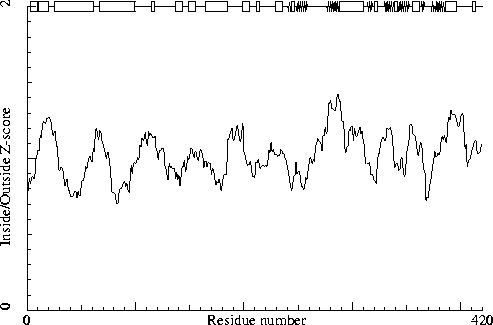
Chain without chain identifier
Secondary structure
Note: Secondary structure
This is the secondary structure according to DSSP. Only helix (H), strand
(S), turn (T) and coil (blank) are shown. [REF]
DBG> SSBOND cards to be written: 0
DBG> SSBOND cards to be written: 0
DBG> SSBOND cards to be written: 0
10 20
| |
1 - 24 MLDTKMLRANFQEIKAKLVHKGED
1 - 24 HHHHHH HHHHHHHHHTTT
30 40 50 60 70 80
| | | | | |
25 - 84 FDKFEALDDRRRELIGKVEELKGKRNEVSQQVAVLKREKKDADHIIKEMREVGEEIKKLD
25 - 84 HHHHHHHHHHHHHHHHHHHHHHHHHHHHHHHHHHHHTT HHHHHHHHHHHHHHHHHH
90 100 110 120 130 140
| | | | | |
85 - 144 EELRTVEAELDTILLSIPNIPHESVPVGETEDDNVEVRKWGEKPSFAYEPKPHWDIADEL
85 - 144 HHHHHHHHHHHHHHHT TTT TT333 T TT HHHHHHHT
150 160 170 180 190 200
| | | | | |
145 - 204 GILDFERAAKVTGSRFVFYKGLGARLERALYNFMLDLHVDEYNYTEVIPPYMVNRASMTG
145 - 204 T HHHHHHHT TT HHHHHHHHHHHHHHHHHHHHTT TT HHHHHH
210
|
205 - 219 TGQLPKFEEDAFKIR
205 - 219 HT TTTT333T
220 230 240 250 260 270
| | | | | |
220 - 279 EEDYFLIPTAEVPITNMHRDEILSGDSLPINYAAFSACFRSEAGSAGRDTRGLIRQHQFN
220 - 279 TTTHHHHHHTTTT SSS333 SSSSSSSSSS T TT T TSSS
280 290 300 310 320 330
| | | | | |
280 - 339 KVELVKFVKPEDSYEELEKLTNQAERVLQLLELPYRVMSMCTGDLGFTAAKKYDIEVWIP
280 - 339 SSSSSSSS 333HHHHHHHHHHHHHHHHHHHT SSSSS 333T TT TSSSSSSSSS3
340 350 360 370 380 390
| | | | | |
340 - 399 SQDTYREISSCSNFEAFQARRANIRFRREAKGKPEHVHTLNGSGLAVGRTVAAILENYQQ
340 - 399 33TSSSSSSSSSS TTHHHHHHT SSS TTT SSS SSSSSSSSSHHHHHHHHHHHT
400 410 420
| | |
400 - 420 EDGSVVIPKVLRPYMGNREVM
400 - 420 TTT TTT333TTT
The contact distances of all atom pairs have been checked. Two atoms are said to `bump' if they are closer than the sum of their Van der Waals radii minus 0.40 Angstrom. For hydrogen bonded pairs a tolerance of 0.55 Angstrom is used. The first number in the table tells you how much shorter that specific contact is than the acceptable limit. The second distance is the distance between the centers of the two atoms.
The last text-item on each line represents the status of the atom pair. The text `INTRA' means that the bump is between atoms that are explicitly listed in the PDB file. `INTER' means it is an inter-symmetry bump. If the final column contains the text 'HB', the bump criterium was relaxed because there could be a hydrogen bond. Similarly relaxed criteria are used for 1--3 and 1--4 interactions (listed as 'B2' and 'B3', respectively). If the last column is 'BF', the sum of the B-factors of the atoms is higher than 80, which makes the appearance of the bump somewhat less severe because the atoms probably aren't there anyway.
Bumps between atoms for which the sum of their occupancies is lower than one are not reported. In any case, each bump is listed in only one direction.
161 VAL ( 163 ) CG2 -- 275 GLN ( 284 ) NE2 1.098 2.002 INTRA 141 ALA ( 143 ) CB -- 147 LEU ( 149 ) CD1 0.947 2.253 INTRA 161 VAL ( 163 ) CG2 -- 275 GLN ( 284 ) CD 0.747 2.453 INTRA 353 PHE ( 362 ) CE2 -- 380 ASN ( 389 ) OD1 0.710 2.090 INTRA 45 LEU ( 47 ) CD1 -- 83 LEU ( 85 ) CD1 0.541 2.659 INTRA 327 THR ( 336 ) CB -- 353 PHE ( 362 ) CE1 0.509 2.691 INTRA 161 VAL ( 163 ) CG2 -- 275 GLN ( 284 ) OE1 0.435 2.365 INTRA 353 PHE ( 362 ) CZ -- 380 ASN ( 389 ) OD1 0.410 2.390 INTRA 308 GLN ( 317 ) O -- 311 GLU ( 320 ) N 0.397 2.303 INTRA 41 LYS ( 43 ) CG -- 83 LEU ( 85 ) CD1 0.390 2.810 INTRA 296 LEU ( 305 ) O -- 300 THR ( 309 ) CG2 0.358 2.442 INTRA 133 GLU ( 135 ) CG -- 134 PRO ( 136 ) CD 0.333 2.867 INTRA 307 LEU ( 316 ) O -- 311 GLU ( 320 ) N 0.324 2.226 INTRA HB 175 TYR ( 177 ) CD1 -- 176 ASN ( 178 ) N 0.324 2.776 INTRA 193 PRO ( 195 ) CB -- 194 PRO ( 196 ) CD 0.304 2.896 INTRA 327 THR ( 336 ) OG1 -- 353 PHE ( 362 ) CE1 0.302 2.498 INTRA 233 ILE ( 242 ) CG2 -- 284 VAL ( 293 ) CG2 0.298 2.902 INTRA 181 LEU ( 183 ) CD1 -- 186 TYR ( 188 ) CE2 0.289 2.911 INTRA 56 VAL ( 58 ) CG2 -- 73 MET ( 75 ) SD 0.277 3.123 INTRA 365 PHE ( 374 ) CE2 -- 374 GLU ( 383 ) CB 0.244 2.956 INTRA 378 THR ( 387 ) C -- 379 LEU ( 388 ) CD2 0.234 2.966 INTRA 10 ASN ( 10 ) O -- 11 PHE ( 11 ) C 0.230 2.570 INTRA BF 320 CYS ( 329 ) O -- 321 THR ( 330 ) C 0.228 2.572 INTRA 223 TYR ( 232 ) C -- 224 PHE ( 233 ) CD1 0.222 2.978 INTRA 352 ASN ( 361 ) ND2 -- 354 GLU ( 363 ) N 0.214 2.786 INTRAAnd so on for a total of 156 lines
The packing environment of the residues is compared with the average packing environment for all residues of the same type in good PDB files. A low packing score can indicate one of several things: Poor packing, misthreading of the sequence through the density, crystal contacts, contacts with a co-factor, or the residue is part of the active site. It is not uncommon to see a few of these, but in any case this requires further inspection of the residue.
270 ARG ( 279 ) -7.37 192 ILE ( 194 ) -6.22 274 ARG ( 283 ) -5.88 113 GLU ( 115 ) -5.63 126 GLU ( 128 ) -5.60 341 GLN ( 350 ) -5.57 267 ARG ( 276 ) -5.55 132 TYR ( 134 ) -5.29 400 GLU ( 409 ) -5.17 130 PHE ( 132 ) -5.02
Average for range 1 - 420 : -0.586
Note: Quality value plot
The quality value smoothed over a 10 residue window is plotted as
function of the residue number. Low areas in the plot (below
-2.0) indicate "unusual" packing.
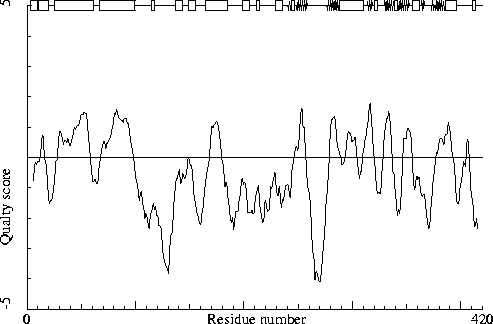
Chain without chain identifier
Warning: Low packing Z-score for some residues
The residues listed in the table below have an unusual packing
environment according to the 2nd generation quality check. The score
listed in the table is a packing normality Z-score: positive means
better than average, negative means worse than average. Only residues
scoring less than -2.50 are listed here. These are the "unusual"
residues in the structure, so it will be interesting to take a
special look at them.
192 ILE ( 194 ) -3.56 273 ILE ( 282 ) -2.67 132 TYR ( 134 ) -2.67 270 ARG ( 279 ) -2.60 361 ALA ( 370 ) -2.53
The table below lists the first and last residue in each stretch found, as well as the average residue Z-score of the series.
270 ARG ( 279 ) --- 273 ILE ( 282 ) -2.41
All contacts : Average = -0.095 Z-score = -0.48
BB-BB contacts : Average = 0.150 Z-score = 1.08
BB-SC contacts : Average = -0.263 Z-score = -1.36
SC-BB contacts : Average = 0.114 Z-score = 0.87
SC-SC contacts : Average = -0.292 Z-score = -1.29
Note: Second generation quality Z-score plot
The second generation quality Z-score smoothed over a 10 residue window
is plotted as function of the residue number. Low areas in the plot (below
-1.3) indicate "unusual" packing.
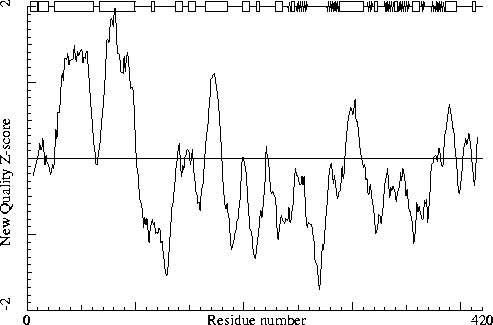
Chain without chain identifier
Note: Backbone oxygen evaluation OK
All residues for which the local backbone conformation could be
found in the WHAT IF database have a normal backbone oxygen
position.
Warning: Unusual rotamers
The residues listed in the table below have a rotamer that is not
seen very often in the database of solved protein structures. This
option determines for every residue the position specific chi-1
rotamer distribution. Thereafter it verified whether the actual
residue in the molecule has the most preferred rotamer or not. If
the actual rotamer is the preferred one, the score is 1.0. If the
actual rotamer is unique, the score is 0.0. If there are two
preferred rotamers, with a population distribution of 3:2 and your
rotamer sits in the lesser populated rotamer, the score will be
0.66. No value will be given if insufficient hits are found in the
database.
It is not necessarily an error if a few residues have rotamer values below 0.3, but careful inspection of all residues with these low values could be worth it.
317 MET ( 326 ) 0.36 380 ASN ( 389 ) 0.38 53 SER ( 55 ) 0.39
For this check, backbone conformations are compared with database structures using C-alpha superpositions with some restraints on the backbone oxygen positions.
A residue mentioned in the table can be part of a strange loop, or there might be something wrong with it or its directly surrounding residues. There are a few of these in every protein, but in any case it is worth looking at!
156 THR ( 158 ) 0 208 LEU ( 210 ) 0 267 ARG ( 276 ) 0 355 ALA ( 364 ) 0 368 GLU ( 377 ) 0 384 LEU ( 393 ) 0 164 LYS ( 166 ) 1 247 LEU ( 256 ) 1 310 LEU ( 319 ) 1 353 PHE ( 362 ) 1 354 GLU ( 363 ) 1 159 ARG ( 161 ) 2 196 MET ( 198 ) 2 370 LYS ( 379 ) 2
Backbone conformation Z-score : 0.169
B-factor analysis
Note: Average B-factor OK
The average B-factor of buried atoms is within expected values for
a room-temperature X-ray study.
Average B-factor for buried atoms : 23.353
Note: Number of buried atoms with low B-factor is OK
For protein structures determined at room temperature, no more than
about 1 percent of the B factors of buried atoms is below 5.0.
Percentage of buried atoms with B less than 5 : 0.13
Error: The B-factors of bonded atoms show signs of over-refinement
For each of the bond types in a protein a distribution was derived
for the difference between the square roots of the B-factors of the
two atoms. All bonds in the current protein were scored against
these distributions. The number given below is the RMS Z-score over
the structure. For a structure with completely restrained B-factors
within residues, this value will be around 0.35, for extremely high
resolution structures refined with free isotropic B-factors this
number is expected to be near 1.0. Any value over 1.5 is sign of
severe over-refinement of B-factors.
RMS Z-score : 2.001 over 2931 bonds
Average difference in B over a bond : 2.44
RMS difference in B over a bond : 6.04
Note: B-factor plot
The average atomic B-factor per residue is plotted as function of
the residue number.
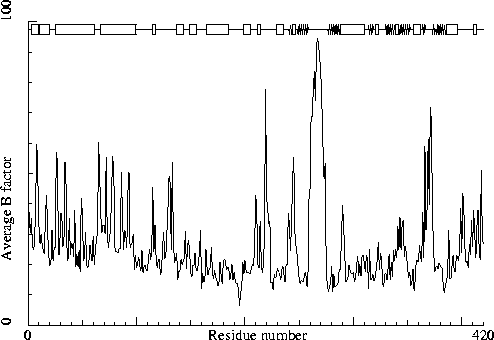
Chain without chain identifier
Hydrogen bond related checks
Error: HIS, ASN, GLN side chain flips
Listed here are Histidine, Asparagine or Glutamine residues for
which the orientation determined from hydrogen bonding analysis are
different from the assignment given in the input. Either they could
form energetically more favorable hydrogen bonds if the terminal
group was rotated by 180 degrees, or there is no assignment in the
input file (atom type 'A') but an assignment could be made. If a
residue is marked ``flexible'' the flipped conformation is only
slightly better than the non-flipped conformation.
250 ASN ( 259 ) 352 ASN ( 361 )
In the table below all normal histidine residues are listed. The assignment based on the geometry of the residue is listed first, together with the RMS Z-score for the fit to the Engh and Huber parameters. For all residues where the H-bond assignment is different, the assignment is listed in the last columns, together with its RMS Z-score to the Engh and Huber parameters.
As always, the RMS Z-scores should be close to 1.0 if the residues were restrained to the Engh and Huber parameters during refinement.
Please note that because the differences between the geometries of the different types are small it is possible that the geometric assignment given here does not correspond to the type used in refinement. This is especially true if the RMS Z-scores are much higher than 1.0.
If the two assignments differ, or the ``geometry'' RMS Z-score is high, it is advisable to verify the hydrogen bond assignment, check the HIS type used during the refinement and possibly adjust it.
20 HIS ( 20 ) HIS-D 0.75 68 HIS ( 70 ) HIS-D 0.73 HIS-E 0.86 106 HIS ( 108 ) HIS-E 0.80 137 HIS ( 139 ) HIS-D 0.69 182 HIS ( 184 ) HIS-D 0.78 HIS-E 0.84 237 HIS ( 246 ) HIS-D 0.89 HIS-E 0.91 276 HIS ( 285 ) HIS-D 0.76 375 HIS ( 384 ) HIS-D 0.78 377 HIS ( 386 ) HIS-E 0.78
Hydrogen bond donors that are buried inside the protein normally use all of their hydrogens to form hydrogen bonds within the protein. If there are any non hydrogen bonded buried hydrogen bond donors in the structure they will be listed here. In very good structures the number of listed atoms will tend to zero.
1 MET ( 1 ) N 67 ASP ( 69 ) N 68 HIS ( 70 ) N 116 ASP ( 118 ) N 118 ASN ( 120 ) N 138 TRP ( 140 ) N 139 ASP ( 141 ) N 160 PHE ( 162 ) N 210 LYS ( 212 ) N 216 PHE ( 218 ) N 221 GLU ( 230 ) N 228 THR ( 237 ) N 229 ALA ( 238 ) N 270 ARG ( 279 ) NH2 271 GLY ( 280 ) N 272 LEU ( 281 ) N 277 GLN ( 286 ) N 294 GLU ( 303 ) N 315 ARG ( 324 ) NE 337 TRP ( 346 ) NE1 343 THR ( 352 ) N 344 TYR ( 353 ) N 357 GLN ( 366 ) N 358 ALA ( 367 ) N 360 ARG ( 369 ) NE 360 ARG ( 369 ) NH2 368 GLU ( 377 ) N 370 LYS ( 379 ) N 372 LYS ( 381 ) N 404 VAL ( 413 ) N
Side-chain hydrogen bond acceptors that are buried inside the protein normally form hydrogen bonds within the protein. If there are any not hydrogen bonded in the optimized hydrogen bond network they will be listed here.
171 GLU ( 173 ) OE2 182 HIS ( 184 ) ND1 237 HIS ( 246 ) ND1 275 GLN ( 284 ) OE1 282 GLU ( 291 ) OE1 380 ASN ( 389 ) OD1 396 ASN ( 405 ) OD1
The second part of the table mostly gives an impression of how well the model conforms to common refinement constraint values. The first part of the table shows a number of constraint-independent quality indicators.
Structure Z-scores, positive is better than average:
1st generation packing quality : -0.214 2nd generation packing quality : -0.478 Ramachandran plot appearance : -1.521 chi-1/chi-2 rotamer normality : -1.103 Backbone conformation : 0.169
Bond lengths : 0.773 Bond angles : 0.894 Omega angle restraints : 0.632 (tight) Side chain planarity : 0.077 (tight) Improper dihedral distribution : 0.539 B-factor distribution : 2.001 (loose) Inside/Outside distribution : 1.033